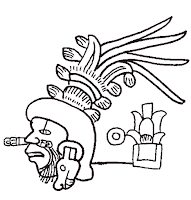We have written before about bearded individuals depicted in Maya art. This is quite rare, as the native Maya did not generally grow beards, and according to some Spanish accounts, they did all they could to prevent facial hair from growing. Obviously, bearded figures stand out as notable, often seen on kings and gods. One of Palenque's founding kings is shown with a beard. Kings at Copán and Quiriguá had themselves depicted on monuments with false beards, much as ancient Pharaohs in Egypt did.
One figure often depicted this way was the Maya sun god. This detail from a mural at Xelhá shows the sun god with a floral breath scroll emanating from his mouth. Flowers and jade appear as Classic-era symbols.While Quetzalcoatl is the Nahuatl name for an Aztec deity, the sun god mentioned here is from Maya belief. He is often shown holding shield and a lance and also became associated with war. By the late Postclassic era, his visual traits include a beard and fangs. This image is from the Madrid Codex. Sometimes, beards are shown on images depicting old men.
Another image of the sun god is on the wooden handle of a sacrificial knife. This instance shows a him in the guise of a diving or descending god, which is a symbol particular to the Yucatán Peninsula. Some of the best known examples are found at Tulum and Cobá. This deity is often associated with the god of bees. The Maya honeybee symbolized a link to the spirit world. This particular image shows iconography on the band of his headdress that combines the solar k'in glyph for day and a floral sign. A turquoise mask, supposedly from Chiapas, Mexico, depicts the sun god with inlaid jaguar fangs. It originally also had a beard and brow made from human hair.
Among the ancient Maya, flowers were closely related with the sun. In Mesoamerica, the sun was portrayed as a bellicose being ruling the afterlife, a floral realm for the brave and virtuous. Flowers symbolized the paradise of the sun, which contained not only flowers, but also precious birds and polished stones. The Aztec solar celestial paradise was where the honored dead became birds and butterflies. Some of this symbolism can be traced back to Teotihuacán, where plumed serpents emerge from giant flowers. The Aztecs placed this realm in the east, which was also the domain of plumed serpents. The feathered serpent is the major symbol of Quetzalcoatl and Kukulkán, his Maya counterpart. Quetzalcoatl has many connections to the east, the dawn, and the Morning Star.
We aren't making direct connections here, but feel that bearded figures are interesting and we aren't the only ones that see possible connections to Old World cultures. Some of the symbolism covered here spans a broad range of time periods and cultures, from Central Mexico to Guatemala and the Yucatán. Some important initial teachings may have been the source of beliefs that have had such a widespread impact.
Much of this content and imagery was taken from At Dawn’s Edge: Tulúm, Santa Rita, and Floral Symbolism in the International Style of Late Postclassic Mesoamerica by Karl Taube.










